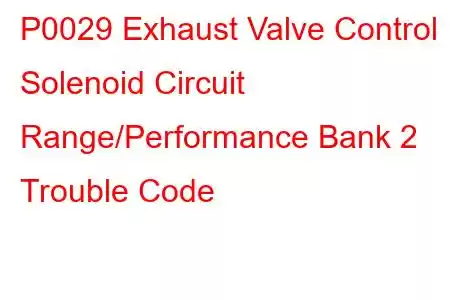P0029 Exhaust Valve Control Solenoid Circuit Range/Perf. B2
OBD-II Trouble Code Technical Description
Exhaust Valve Control Solenoid Circuit Range/Performance Bank 2
What does that mean?
This diagnostic trouble code (DTC) is a generic powertrain code, which means that it applies to OBD-II equipped vehicles, including but not limited to Toyota, VW, Ford, Dodge, Honda, Chevrolet, Hyundai, Audi, Acura, etc. Specific repair steps may vary depending on the model.
On vehicles equipped with variable valve timing (VVT), camshafts are controlled by hydraulic actuators fed by the engine oil system through control solenoids by the engine control module/powertrain control module (ECM/PCM). The ECM/PCM has detected the range of movement of the exhaust camshaft on bank 1 is out of specifications or not operating when commanded. Bank 2 refers to the side of the engine opposite from cylinder #1 - be sure to verify which side is correct according to manufacturers specifications. The exhaust valve control solenoid is typically located on the exhaust manifold side of the cylinder head.
Note: This code may also be associated with codes P0078, P0079 or P0080 - if any of these codes exist, fix the solenoid problem before proceeding with diagnosing the circuit range/performance issue. This code is similar to codes P0026, P0029, and P0028.
Symptoms
Symptoms of a P0029 DTC may include:
MIL (Malfunction Indicator Lamp) illumination Poor acceleration or engine performance Decreased fuel economyCauses
Potential causes of a P0029 diagnostic trouble code may include:
Low engine oil level or contaminated oil Clogged oil system Malfunctioning control solenoid Malfunctioning camshaft actuator Timing chain/belt loose or incorrectly adjusted Malfunctioning ECM/PCMPossible Solutions
Engine oil - Check the engine oil level to make sure engine oil capacity is sufficient. Since the actuators work on oil pressure, the proper amount of oil is critical to ensure proper operation of the VVT system. Dirty or contaminated fluid may cause buildup which can lead to failure of the control solenoid or the camshaft actuator.
Control solenoid - The control solenoid for the camshaft can be checked for continuity using a Digital volt/ohm meter (DVOM) using the ohms function, by unplugging the solenoid wiring harness connector and checking the resistance of the solenoid with the (+) and (-) leads of the DVOM on each terminal. Ensure the internal resistance is within manufacturers specifications if available. If resistance is within specifications, remove the control solenoid to verify it is not contaminated, or if there is damage to the sealing O rings to cause a loss of oil pressure.
Camshaft actuator - The camshaft actuator is a mechanical device controlled by internal spring pressure and adjusted by oil supplied by the control solenoid. When no oil pressure is supplied, it will default to a "safe" position. Refer to the manufacturers suggested procedure to remove the camshaft actuator from the engine's camshaft to ensure no leaks are present that would cause a loss of oil pressure to and from the actuator's hydraulic supply/return feed lines or within the actuator itself. Check timing chain/belt and components to ensure they are in proper working order and installed in the correct position on the camshaft gear.
ECM/PCM - The ECM/PCM commands the control solenoid using a Pulse width modulated signal (PWM) to regulate the amount of on/off time, resulting in a control of the pressure used to move the camshaft actuator. A graphing multimeter or oscilloscope tool is required to view the PWM signal to ensure proper operation of the ECM/PCM. To check the PWM signal, the positive (+) lead is tapped into the ground side of the control solenoid ( if supplied by constant voltage, ground controlled ) or the powered side of the control solenoid (if permanently grounded, positive control ) and the negative (-) lead is attached to a good known ground. If the PWM signal is not consistent with changes in engine RPM, there may be a problem with the ECM/PCM.
Read: 50


